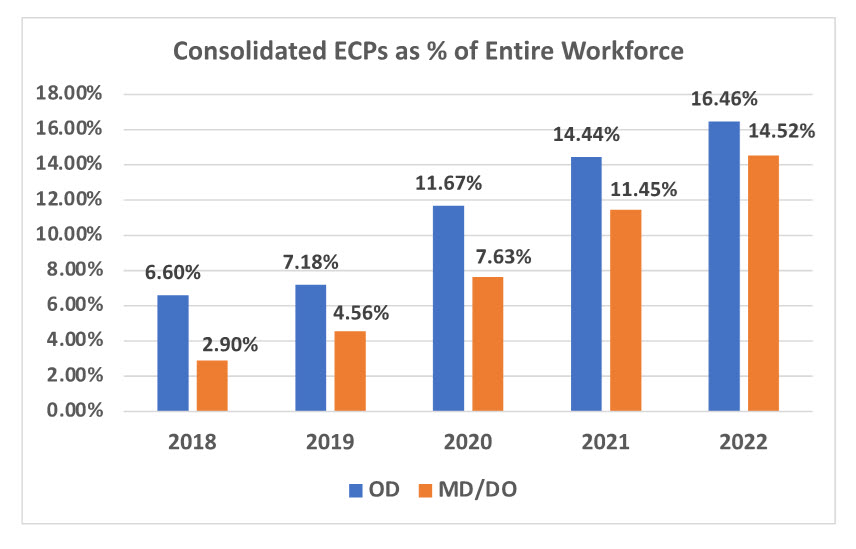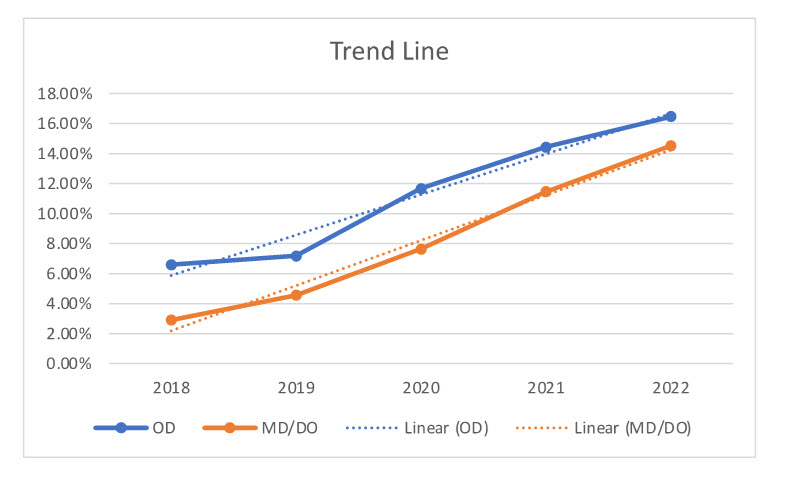
By Richard Edlow, OD,
The Eyeconomist
July 27, 2022
The April 2022 issue of Vision Monday delivered an excellent overview of the trends in eyecare practice consolidation and practice transition. The landscape of what has traditionally been a highly fragmented industry has been gradually shifting over the past five years. I have been tracking the private equity investments in eyecare over this time, specifically quantifying the number of optometrists and ophthalmologists practicing in the world of private equity.
Our industry is relatively recession-resistant with excellent growth potential, thereby presenting opportunities for private equity healthcare investors who are sitting on significant dollars (“dry powder”) in their funds. Private equity investments in eyecare began in 2014 with the acquisition of Katzen Eye Group in Baltimore by Varsity Healthcare Partners (note: I was CEO of Katzen Eye Group at the time). Since then, there has been notable activity in the sector including “retail” optometry, medically focused optometry groups, vertical integrations (optical, optometry and ophthalmology), as well as sub-specialty retina care.
As of May 2022, there are 51 private equity-backed eyecare platforms and 12 additional consolidations that have yet to transact with an outside investor.
A snapshot of 2018 shows that 6.6 percent of all optometrists in the U.S. and 2.9 percent of ophthalmologists practiced in one of the private equity eyecare platforms. The rate of growth has been somewhat parallel for the two professions (figures 1 & 2 below).
Figure 1

Figure 2

Data for Figures 1 &2

As the industry consolidation continues, the market share of ODs & MD/DOs now stands at 16.5 percent and 14.5 percent respectively. In actual numbers this represents approximately 7,771 optometrists of the 47,209 in the U.S. in 2022 and 2,440 of the 16,810 practicing ophthalmologists. These market share numbers do not include the providers in entities such as LensCrafters, Pearle Vision, Costco Optical or Walmart Vision Centers.
Other Articles to Explore
Demand for eyecare services will continue to grow in the U.S., especially for age-related conditions. Demand growth will outstrip the supply (of eyecare providers) for decades setting up superior financial results for well-run practices. These dynamics apply to both private practice settings and private equity consolidation platforms. One can expect mergers and acquisitions to continue their pace for many years to come.
 Richard Edlow, OD, known as the Eyeconomist, recently retired from clinical care. To contact him: redlow@aol.com
Richard Edlow, OD, known as the Eyeconomist, recently retired from clinical care. To contact him: redlow@aol.com

























